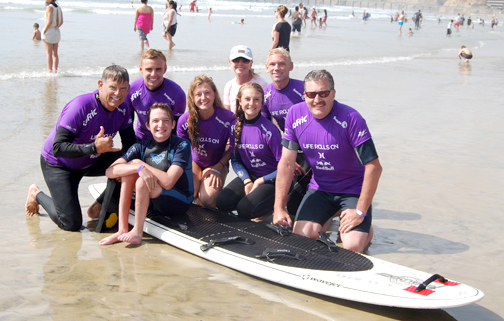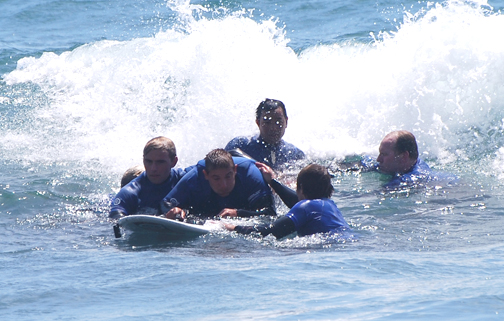
Hunter Leum, far left, and Garrett Leum, far right, work with a volunteer to help surfers at They Will Surf Again.
By Mary O’KEEFE
If there is one thing Californians know about it is surfing. In Redondo Beach there is even a statue to the “First Surfer in the United States,” George Freeth. The story is Freeth, of Hawaiian and Irish ancestry, was born in Honolulu in 1883. One day in 1907, Henry E. Huntington saw Freeth surfing and invited him to Redondo Beach. People, numbering in the thousands, came to see this new phenomenon and surfing became part of the California culture, extending even into music.
“Hey, surfing’s getting really big. You guys ought to write a song about it.”
~ Beach Boys’ Dennis Wilson to his brother Brian and Mike Love in 1961.
Beyond the movies and music is the feeling that surfers get from catching the perfect wave.
“It’s hard for me to imagine not surfing. It brings me the most happiness of anything I have ever done,” said Garrett Leum.

Leum, a Crescenta Valley High School 2014 graduate, has been surfing since he was 6 years old. He, his older brother Hunter, dad Mike and mom Nancy spend a lot of time at the beach. For years the Leums have volunteered with Life Rolls On/They Will Surf Again, sharing their love of surfing with those who have never been on a surfboard and others who thought they would never surf again. On July 12, they once again volunteered with LRO/TWSA.
Jesse Billauer sustained a spinal cord injury while surfing, which resulted in quadriplegia, started LRO. His injury did not stop his love of surfing and in 2001 he teamed up with They Will Surf Again, a foundation with similar goals to introduce adaptive surfing for the paralysis community, according to the Life Rolls On website.
Seven years ago, Hunter’s CVHS swim coach took the team to volunteer with LRO/TWSA.
“That was the first time I [heard of the organization],” Hunter said. “Until then I had no idea [this program] existed.”
At that point, Hunter introduced his family to the organization and they have been volunteering ever since.
The volunteers work in deep, mid-level and shallow water as well as on land. Participants are quadriplegic and paraplegic people of all ages. Some have surfed in the past and, for others, it is their first time. They are helped onto a specially designed surfboard and the mid-level water volunteers take them to the deep-water volunteers.

Then, just like all surfers, they wait for that perfect wave and, with the help of a volunteer guiding the board, they ride the wave to the shore where the shallow water volunteers grab the board, turn it around and the surfer goes back for another wave.
“A lot of the surfers are skeptical, but once they [try it] they want to go again,” Garrett said. “[It’s great] seeing how happy the surfers are once they get a wave.”
“The [surfers] look forward to it,” Hunter said of those who participated before.
In fact, some like it so much they can’t wait for the next TWSA. Over the years, the Leums have made friends with some of the surfers. One is a woman from northern California who came back to Southern California beaches to surf again with the Leums.
“She didn’t even like surfing [at first],” Garrett said, but being in the water “made her forget she couldn’t use her legs.”
“It’s such a humbling experience,” Hunter said of volunteering. “It makes you feel good.”
The love of surfing and the freedom it can offer is universal, and those who volunteer for LRO/TWSA are inspired as they share that feeling with others.
To find out more about Life Rolls On, visit www.liferollson.org.
